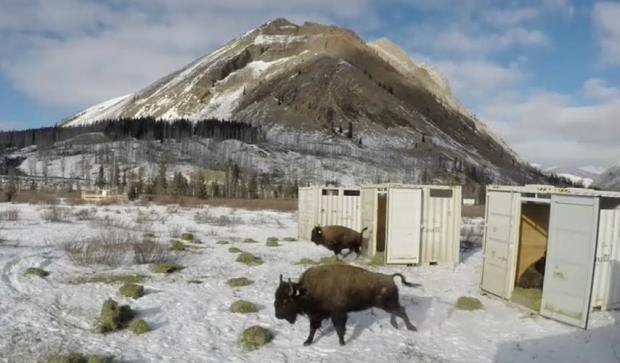
By Lisa Monforton, CBC News
The first wild bison to roam Banff National Park in more than a century have been transported to a remote valley in a “historic homecoming” aimed at re-establishing a thriving herd, Parks Canada said Monday.
While many remember what Parks Canada calls a “display herd” of bison housed in a paddock near the Banff townsite until 1997, this new herd represents a return to wild animals, eventually free to wander their surroundings.
The 16 bison — primarily pregnant two year olds — were loaded onto shipping containers on trucks in Elk Island National Park, about 35 kilometres east of Edmonton, and transported to the park in the past week.
The shipping containers were ferried by helicopter over the slopes and lowered into an enclosed pasture in Panther Valley near Sundre on the eastern slopes of the park.
The bison were let out into the pasture, where they’ll stay for 16 months while being closely monitored by Parks Canada using radio collars.
Eventually, in the summer of 2018, they’ll be released into a 1,200-square-kilometre area on the eastern slopes of the park, where they can interact with other native species, forage for food and integrate into the ecosystem.
Harvey Locke, a conservationist, writer and trustee with the Eleanor Luxton Historical Foundation in Banff, deemed the day a historic moment.
“This is a great day for Banff National Park. It’s a great day for Canada and frankly, it’s one of the great days for wildlife conservation in the history of North America,” Locke said.
Local conservationists involved in the relocation said they were relieved the moving process went so smoothly after years of research, preparations and consultations with various groups.
Karsten Heuer, a conservationist and adviser in the project, hailed it as a “big first step in bringing bison back to Banff National Park.”
“It’s a huge relief to actually have hooves on the ground,” Heuer said.
The longer-term goal is to re-establish a new wild population of bison in Banff National Park and help the conservation of the animal nationally and internationally.
While conservation groups have applauded the idea, ranchers on the eastern slopes have criticized the plan. They’re worried the bison could escape, damage property or spread disease to livestock.
But advocates for relocation say due diligence has been done on the five-year pilot project, which includes constant monitoring.
Locke said it’s only natural the bison should be roaming the park again.
“Restoring wild bison … is the righting of wrong that was caused in the 19th century when we almost eliminated wild bison as a species.… Banff Park was involved in saving the species from extinction 100 years ago, and today it’s involved in restoring this species as part of the landscape, as a wild animal, and that is really exciting,” Locke said.
Locke doesn’t think the bison will have any trouble adapting.
“I don’t think the challenges for this herd are very large, because we know from the archeological record that bison were in this park for over 10,000 years.… I think it’s going to go very, very well, because it’s a native species in its native habitat.”
Heuer called the move just the beginning.
“As we move forward, one thing we are really going to pay close attention to is bringing Canadians along on the story,” Heuer said.
Ideas include continuing public education and awareness, with a chance for volunteer opportunities to learn more about the bison, Heuer said.

Mark my words, this will result in a destruction of the range land. Bison (and periodic fire) played a key role in the evolution of the parries. But, I doubt seriously (would actually bet on it) that those in charge of this project do not have a clue as to how to get a small herd of bison to mimic what the massive herds of the Western Frontier did to get the results they got–a healthy ecosystem.
This might give you a little bit of a hint as to what/how range ecosystems work. http://www.landandlivestockinternational.com